美国的生化考题
生化实战测试题及答案

生化实战测试题及答案一、选择题(每题2分,共20分)1. 蛋白质合成的主要场所是:A. 细胞核B. 线粒体C. 核糖体D. 高尔基体答案:C2. 以下哪种酶在DNA复制过程中起作用?A. 逆转录酶B. 限制性内切酶C. 聚合酶D. 转录酶答案:C3. 细胞呼吸的主要场所是:A. 细胞核B. 线粒体C. 核糖体D. 高尔基体答案:B4. 以下哪种物质是细胞膜的主要成分?A. 蛋白质B. 核酸C. 糖类D. 脂质答案:D5. 以下哪种氨基酸是必需氨基酸?A. 丙氨酸B. 亮氨酸C. 色氨酸D. 谷氨酸答案:C6. 以下哪种物质是细胞内能量的主要储存形式?A. ATPB. ADPC. 葡萄糖D. 脂肪答案:D7. 以下哪种物质是DNA复制的原料?A. 氨基酸B. 核苷酸C. 脂肪酸D. 葡萄糖答案:B8. 以下哪种物质是细胞内信号传导的重要分子?A. 蛋白质B. 激素C. 核酸D. 脂质答案:B9. 以下哪种物质是细胞内蛋白质合成的直接模板?A. DNAB. mRNAC. tRNAD. rRNA答案:B10. 以下哪种物质是细胞内遗传信息的主要载体?A. DNAB. RNAC. 蛋白质D. 糖类答案:A二、填空题(每空1分,共20分)1. 蛋白质的基本单位是______。
答案:氨基酸2. DNA的双螺旋结构由两条______链组成。
答案:互补3. 细胞周期包括______期和______期。
答案:间/有丝分裂4. 细胞膜的主要功能是______和______。
答案:选择性通透/细胞识别5. 细胞内ATP的生成主要依赖于______。
答案:细胞呼吸6. 细胞内蛋白质合成的场所是______。
答案:核糖体7. 细胞内DNA复制的酶是______。
答案:DNA聚合酶8. 细胞内mRNA的合成过程称为______。
答案:转录9. 细胞内蛋白质合成的直接模板是______。
答案:mRNA10. 细胞内遗传信息的主要载体是______。
美国化学考试题目及答案
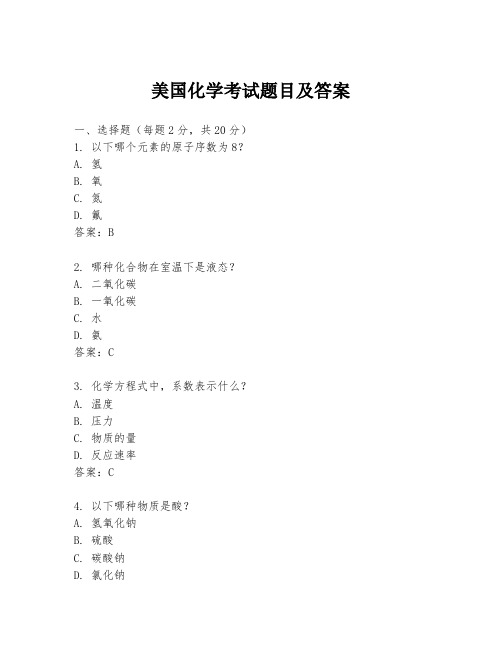
美国化学考试题目及答案一、选择题(每题2分,共20分)1. 以下哪个元素的原子序数为8?A. 氢B. 氧C. 氮D. 氟答案:B2. 哪种化合物在室温下是液态?A. 二氧化碳B. 一氧化碳C. 水D. 氨答案:C3. 化学方程式中,系数表示什么?A. 温度B. 压力C. 物质的量D. 反应速率答案:C4. 以下哪种物质是酸?A. 氢氧化钠B. 硫酸C. 碳酸钠D. 氯化钠答案:B5. 元素周期表中,元素按照什么顺序排列?A. 原子量B. 原子序数C. 电子数D. 电子层数答案:B6. 以下哪种反应是氧化还原反应?A. 酸碱中和B. 置换反应C. 合成反应D. 分解反应答案:B7. 以下哪种物质是电解质?A. 乙醇B. 氯化钠C. 葡萄糖D. 石蜡答案:B8. 哪种元素是最轻的气体?A. 氢B. 氦C. 氮D. 氧答案:A9. 以下哪种物质是强碱?A. 氢氧化钠B. 氢氧化钙C. 氢氧化钾D. 氢氧化镁答案:A10. 哪种元素的符号是Fe?A. 铜B. 铁C. 银D. 金答案:B二、填空题(每空1分,共20分)1. 元素周期表中,元素按照原子序数递增的顺序排列。
2. 化学反应中,如果反应物和生成物的总能量不同,则该反应是_______反应。
答案:放热/吸热3. 酸和碱反应生成盐和水的反应称为_______反应。
答案:中和4. 元素周期表中,第IA族的元素具有_______个价电子。
答案:15. 金属元素通常具有_______价电子。
答案:较少6. 化合物中,氧元素的化合价通常为_______。
答案:-27. 根据元素周期表,元素的原子半径随着原子序数的增加而_______。
答案:先增大后减小8. 元素的电负性是指元素原子对_______的吸引力。
答案:电子9. 在有机化学中,碳原子通常形成_______个共价键。
答案:410. 元素的化学性质主要取决于其原子的_______。
答案:最外层电子数三、简答题(每题10分,共30分)1. 描述什么是化学平衡,并给出一个例子。
生化英文试题及答案
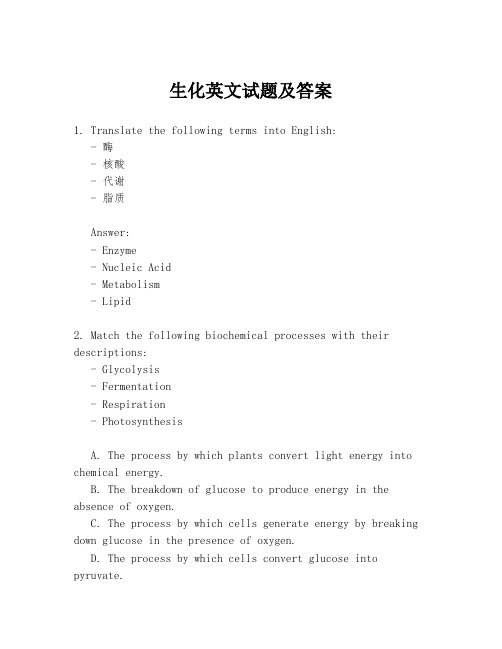
生化英文试题及答案1. Translate the following terms into English:- 酶- 核酸- 代谢- 脂质Answer:- Enzyme- Nucleic Acid- Metabolism- Lipid2. Match the following biochemical processes with their descriptions:- Glycolysis- Fermentation- Respiration- PhotosynthesisA. The process by which plants convert light energy into chemical energy.B. The breakdown of glucose to produce energy in the absence of oxygen.C. The process by which cells generate energy by breaking down glucose in the presence of oxygen.D. The process by which cells convert glucose into pyruvate.Answer:- Glycolysis: D- Fermentation: B- Respiration: C- Photosynthesis: A3. What is the role of ATP in cellular processes?Answer:ATP, or adenosine triphosphate, serves as the primary energy currency of the cell. It is used to power various cellular processes, such as muscle contraction, active transport across cell membranes, and synthesis of biomolecules.4. List the four types of RNA and their functions:Answer:- mRNA (messenger RNA): Carries genetic information from DNA to the ribosome for protein synthesis.- tRNA (transfer RNA): Transfers specific amino acids to the ribosome during protein synthesis.- rRNA (ribosomal RNA): Forms part of the ribosome, which is the site of protein synthesis.- snRNA (small nuclear RNA): Involved in the processing of pre-mRNA in the cell nucleus.5. Describe the structure of a typical protein.Answer:A typical protein is composed of one or more polypeptide chains, each made up of amino acids linked together by peptide bonds. The structure of a protein can be described at four levels:- Primary structure: The linear sequence of amino acids. - Secondary structure: Local folding patterns such as alpha-helices and beta-sheets.- Tertiary structure: The overall three-dimensional shape of the protein, stabilized by hydrogen bonds, ionic bonds, and hydrophobic interactions.- Quaternary structure: The arrangement of multiple polypeptide chains in a multi-subunit protein.6. What are the main differences between prokaryotic and eukaryotic cells?Answer:The main differences between prokaryotic and eukaryotic cells include:- Prokaryotic cells lack a nucleus and membrane-bound organelles, while eukaryotic cells have a nucleus and various membrane-bound organelles.- Prokaryotic cells have a simpler genome, often in the form of a single circular DNA molecule, whereas eukaryotic cells have a more complex, linear DNA organized into multiple chromosomes.- Prokaryotic cells are generally smaller than eukaryotic cells.- Prokaryotic cells reproduce by binary fission, while eukaryotic cells reproduce by mitosis and meiosis.7. Explain the concept of enzyme specificity.Answer:Enzyme specificity refers to the ability of an enzyme to catalyze a particular chemical reaction involving specific substrates. This specificity is due to the unique shape of the enzyme's active site, which allows it to bind only to certain molecules, ensuring that the enzyme can only catalyze the intended reaction.8. What is the role of the citric acid cycle (Krebs cycle) in cellular respiration?Answer:The citric acid cycle, also known as the Krebs cycle or tricarboxylic acid cycle, plays a central role in cellular respiration by oxidizing acetyl-CoA derived from carbohydrates, fats, and proteins into carbon dioxide, while generating NADH and FADH2, which are electron carriers that feed into the electron transport chain to produce ATP.。
美国生物学试题及答案
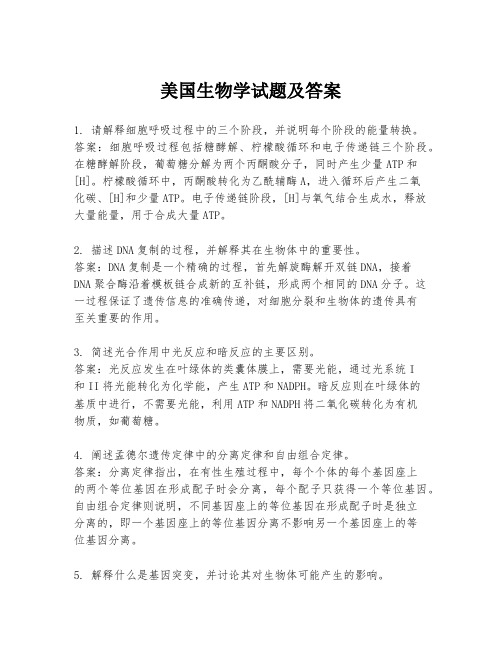
美国生物学试题及答案1. 请解释细胞呼吸过程中的三个阶段,并说明每个阶段的能量转换。
答案:细胞呼吸过程包括糖酵解、柠檬酸循环和电子传递链三个阶段。
在糖酵解阶段,葡萄糖分解为两个丙酮酸分子,同时产生少量ATP和[H]。
柠檬酸循环中,丙酮酸转化为乙酰辅酶A,进入循环后产生二氧化碳、[H]和少量ATP。
电子传递链阶段,[H]与氧气结合生成水,释放大量能量,用于合成大量ATP。
2. 描述DNA复制的过程,并解释其在生物体中的重要性。
答案:DNA复制是一个精确的过程,首先解旋酶解开双链DNA,接着DNA聚合酶沿着模板链合成新的互补链,形成两个相同的DNA分子。
这一过程保证了遗传信息的准确传递,对细胞分裂和生物体的遗传具有至关重要的作用。
3. 简述光合作用中光反应和暗反应的主要区别。
答案:光反应发生在叶绿体的类囊体膜上,需要光能,通过光系统I和II将光能转化为化学能,产生ATP和NADPH。
暗反应则在叶绿体的基质中进行,不需要光能,利用ATP和NADPH将二氧化碳转化为有机物质,如葡萄糖。
4. 阐述孟德尔遗传定律中的分离定律和自由组合定律。
答案:分离定律指出,在有性生殖过程中,每个个体的每个基因座上的两个等位基因在形成配子时会分离,每个配子只获得一个等位基因。
自由组合定律则说明,不同基因座上的等位基因在形成配子时是独立分离的,即一个基因座上的等位基因分离不影响另一个基因座上的等位基因分离。
5. 解释什么是基因突变,并讨论其对生物体可能产生的影响。
答案:基因突变是指DNA序列发生改变的现象,这种改变可能是单个核苷酸的替换、插入或缺失。
基因突变可能导致蛋白质结构和功能的改变,从而影响生物体的表型。
突变可能是有害的、有益的或中性的,对生物体的生存和进化具有重要影响。
6. 描述人类免疫系统的三个主要防线,并解释它们的作用。
答案:人类免疫系统的三个主要防线包括物理屏障、先天免疫和适应性免疫。
物理屏障如皮肤和粘膜可以阻止病原体进入体内。
美国生物学试题及答案解析
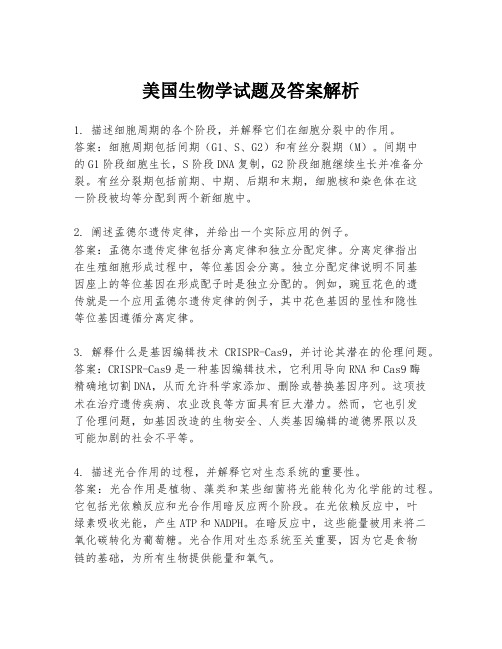
美国生物学试题及答案解析1. 描述细胞周期的各个阶段,并解释它们在细胞分裂中的作用。
答案:细胞周期包括间期(G1、S、G2)和有丝分裂期(M)。
间期中的G1阶段细胞生长,S阶段DNA复制,G2阶段细胞继续生长并准备分裂。
有丝分裂期包括前期、中期、后期和末期,细胞核和染色体在这一阶段被均等分配到两个新细胞中。
2. 阐述孟德尔遗传定律,并给出一个实际应用的例子。
答案:孟德尔遗传定律包括分离定律和独立分配定律。
分离定律指出在生殖细胞形成过程中,等位基因会分离。
独立分配定律说明不同基因座上的等位基因在形成配子时是独立分配的。
例如,豌豆花色的遗传就是一个应用孟德尔遗传定律的例子,其中花色基因的显性和隐性等位基因遵循分离定律。
3. 解释什么是基因编辑技术CRISPR-Cas9,并讨论其潜在的伦理问题。
答案:CRISPR-Cas9是一种基因编辑技术,它利用导向RNA和Cas9酶精确地切割DNA,从而允许科学家添加、删除或替换基因序列。
这项技术在治疗遗传疾病、农业改良等方面具有巨大潜力。
然而,它也引发了伦理问题,如基因改造的生物安全、人类基因编辑的道德界限以及可能加剧的社会不平等。
4. 描述光合作用的过程,并解释它对生态系统的重要性。
答案:光合作用是植物、藻类和某些细菌将光能转化为化学能的过程。
它包括光依赖反应和光合作用暗反应两个阶段。
在光依赖反应中,叶绿素吸收光能,产生ATP和NADPH。
在暗反应中,这些能量被用来将二氧化碳转化为葡萄糖。
光合作用对生态系统至关重要,因为它是食物链的基础,为所有生物提供能量和氧气。
5. 阐述进化论的基本原理,并给出一个支持进化论的化石证据。
答案:进化论的基本原理包括共同祖先、自然选择、遗传变异和物种形成。
自然选择是进化的主要驱动力,它解释了生物特征如何适应环境并传递给后代。
化石证据,如始祖鸟化石,显示了鸟类和恐龙之间的过渡形态,支持了鸟类是从恐龙进化而来的观点。
美国生物考试试题

美国生物考试试题美国生物考试试题生物学是一门研究生命现象和生命规律的科学,它关注着生物体的结构、功能、进化以及与环境的相互作用。
在美国,生物学作为一门重要的科目,被广泛地教授和考察。
本文将以美国生物考试试题为主题,从不同的角度探讨生物学的相关知识。
一、细胞生物学细胞是生物学研究的基本单位,也是生命的基础。
在美国生物考试中,细胞生物学是一个重要的考点。
以下是一道典型的细胞生物学试题:问题:细胞膜的主要功能是什么?答案:细胞膜是细胞的外界环境与细胞内环境之间的界面,它具有多种功能。
其中主要功能包括维持细胞内外环境的稳定,调控物质的进出,保护细胞免受外界的伤害,以及参与细胞间的信号传递等。
二、遗传学遗传学是研究遗传现象和遗传规律的学科,它探讨了基因在遗传传递中的作用和影响。
在美国生物考试中,遗传学是一个重要的考点。
以下是一道典型的遗传学试题:问题:下列哪个是遗传物质的基本单位?A. 蛋白质B. 脂质C. 碳水化合物D. DNA答案:D. DNA(脱氧核糖核酸)是遗传物质的基本单位。
DNA由核苷酸组成,每个核苷酸由一个糖分子、一个磷酸分子和一个碱基分子组成。
DNA通过遗传密码的方式传递和储存遗传信息。
三、生态学生态学研究生物与环境之间的相互作用关系,关注着生物体在不同环境条件下的适应性和相互依存关系。
在美国生物考试中,生态学是一个重要的考点。
以下是一道典型的生态学试题:问题:下列哪个因素对生态系统的稳定性影响最大?A. 温度变化B. 水资源的供应C. 物种多样性D. 光照强度答案:C. 物种多样性对生态系统的稳定性影响最大。
物种多样性可以提供更多的生物功能和生态服务,增加生态系统的抵抗力和恢复力,减少环境变化对生态系统的冲击。
四、进化生物学进化生物学研究生物种群的遗传变异和演化过程,探讨了生物多样性的形成和维持机制。
在美国生物考试中,进化生物学是一个重要的考点。
以下是一道典型的进化生物学试题:问题:下列哪个是进化的基本驱动力?A. 突变B. 自然选择C. 基因流D. 遗传漂变答案:B. 自然选择是进化的基本驱动力。
美国生物考试题及答案
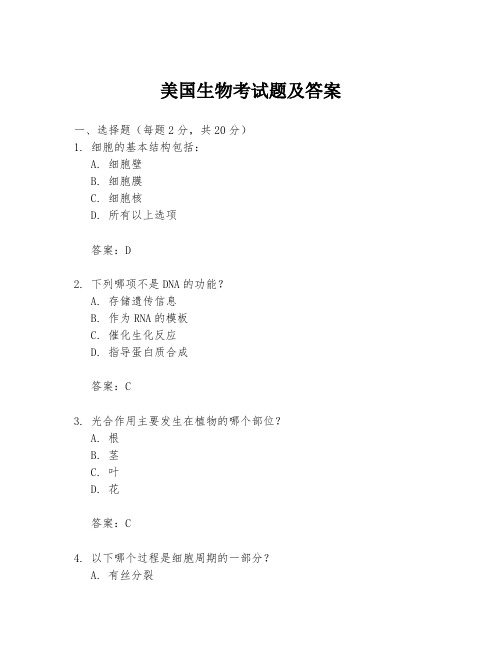
美国生物考试题及答案一、选择题(每题2分,共20分)1. 细胞的基本结构包括:A. 细胞壁B. 细胞膜C. 细胞核D. 所有以上选项答案:D2. 下列哪项不是DNA的功能?A. 存储遗传信息B. 作为RNA的模板C. 催化生化反应D. 指导蛋白质合成答案:C3. 光合作用主要发生在植物的哪个部位?A. 根B. 茎C. 叶D. 花答案:C4. 以下哪个过程是细胞周期的一部分?A. 有丝分裂B. 减数分裂C. 细胞凋亡D. 细胞分化答案:A5. 以下哪个选项是孟德尔遗传定律之一?A. 显性定律B. 独立分离定律C. 连锁定律D. 所有以上选项答案:D二、填空题(每空1分,共10分)1. 人体最大的器官是________。
答案:皮肤2. 酶是一种能够________生化反应速率的蛋白质。
答案:催化3. 人类的染色体数量是________。
答案:464. 细胞分裂过程中,染色体数量加倍发生在________。
答案:有丝分裂前期5. 遗传信息的传递是通过________实现的。
答案:DNA复制三、简答题(每题10分,共30分)1. 描述细胞膜的主要功能。
答案:细胞膜是细胞的外层结构,具有保护细胞内部环境稳定、控制物质进出细胞、传递细胞内外信号等功能。
2. 解释什么是基因突变,并举例说明其可能的影响。
答案:基因突变是指DNA序列的改变,这种改变可能导致蛋白质结构和功能的改变,进而影响个体的性状。
例如,镰状细胞贫血症就是由血红蛋白基因突变引起的。
3. 阐述生态系统中能量流动的特点。
答案:生态系统中的能量流动是单向的,从生产者到消费者,再到分解者,逐级递减。
能量在流动过程中会有损失,主要因为生物体的呼吸作用和排泄等。
四、论述题(共40分)1. 讨论达尔文的自然选择理论及其对现代生物学的影响。
(20分)答案:达尔文的自然选择理论认为,在生存斗争中,适应环境的个体更有可能生存并繁衍后代,从而使得有利基因在种群中逐渐增加。
生化技能大赛初赛试题答案

生化技能大赛初赛试题答案一、选择题1. 生化技能大赛中,以下哪项是核酸的主要成分?A. 蛋白质B. 脂质C. 碳水化合物D. 核苷酸正确答案:D2. 在生物体内,催化特定化学反应的生物大分子是:A. 酶B. 激素C. 抗体D. 核酸正确答案:A3. 以下哪种物质不是细胞呼吸的产物?A. 二氧化碳B. 水C. 氧气D. 丙酮酸正确答案:C4. DNA双螺旋结构是由哪两位科学家首次提出的?A. 达尔文和华莱士B. 克里克和沃森C. 莫诺和雅各布D. 摩尔根和萨顿正确答案:B5. 生物合成中,三羧酸循环的第一步是由哪种酶催化的?A. 柠檬酸合成酶B. 柠檬酸脱氢酶C. 苹果酸脱氢酶D. 丙酮酸脱氢酶正确答案:D二、填空题1. 在蛋白质合成过程中,______是连接在mRNA上决定氨基酸序列的三个相邻核苷酸。
答案:密码子2. 细胞膜的流动性主要是由于其主要由______分子构成。
答案:磷脂3. 在生物体内,______是细胞内主要的能量储存物质。
答案:糖原4. 核苷酸是由______、糖和磷酸组成的。
答案:含氮碱基5. 真核细胞中,______是细胞内进行蛋白质合成的细胞器。
答案:核糖体三、简答题1. 请简述酶的催化机制。
答:酶是高效的生物催化剂,它们通过降低化学反应的活化能来加速反应的进行。
酶的催化机制通常包括:(1) 形成酶-底物复合物,底物与酶的活性位点结合,使底物更易于反应;(2) 转化阶段,酶通过稳定底物的过渡态,使得反应更容易进行;(3) 生成产物并释放,反应完成后,产物从酶的活性位点脱离,酶恢复原状,可以再次参与催化。
2. 描述细胞呼吸的基本过程。
答:细胞呼吸是细胞获取能量的过程,主要包括三个阶段:(1) 糖酵解,发生在细胞质中,将葡萄糖分解成两个丙酮酸分子,产生少量ATP和NADH;(2) 柠檬酸循环,也称为克雷布斯循环,发生在线粒体基质中,彻底氧化丙酮酸,产生CO2、ATP和更多的NADH;(3) 电子传递链和化学渗透,发生在线粒体内膜上,NADH和FADH2将电子传递给电子传递链上的一系列载体,最终传递给氧气,产生大量的ATP。
2023年医学生物技术实验员考试题库及答案
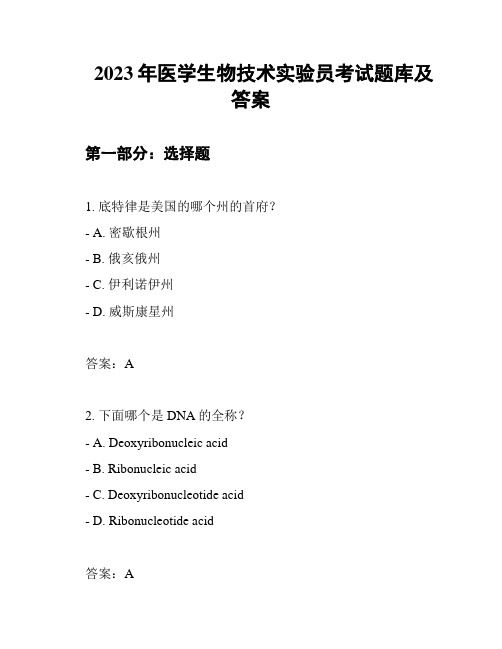
2023年医学生物技术实验员考试题库及答案第一部分:选择题1. 底特律是美国的哪个州的首府?- A. 密歇根州- B. 俄亥俄州- C. 伊利诺伊州- D. 威斯康星州答案:A2. 下面哪个是DNA的全称?- A. Deoxyribonucleic acid- B. Ribonucleic acid- C. Deoxyribonucleotide acid- D. Ribonucleotide acid答案:A3. 酶是一种具有特定催化活性的蛋白质,它在生物体的生化反应中起到加速特定反应的作用。
下面哪个选项不是酶的特点?- A. 酶是高效的催化剂- B. 酶的作用是不可逆的- C. 酶对反应物的结构没有要求- D. 酶对温度和pH值的影响比较大答案:B第二部分:判断题1. DNA双螺旋结构是由两条单链互相缠绕而成的。
- 正确/错误答案:正确2. PCR(聚合酶链式反应)是在体外扩增DNA的方法。
- 正确/错误答案:正确3. 细胞膜是由脂质分子构成的。
- 正确/错误答案:正确第三部分:简答题1. 请简要解释PCR技术的原理和应用。
答案:PCR是一种体外扩增DNA的方法。
其原理是通过不断重复的循环反应,在一定条件下,利用DNA聚合酶酶活性,实现DNA模板的复制。
PCR广泛应用于医学、生物学、生物技术等领域,例如基因检测、基因工程等。
2. 请简述细胞膜在细胞中的功能。
答案:细胞膜是细胞的外包膜,主要由脂质分子组成。
细胞膜在细胞中具有控制物质进出的作用,保持细胞内外的不同环境,参与细胞信号传导和细胞内物质运输等功能。
以上是2023年医学生物技术实验员考试题库及答案的一部分,供参考。
美国生物考试题及答案
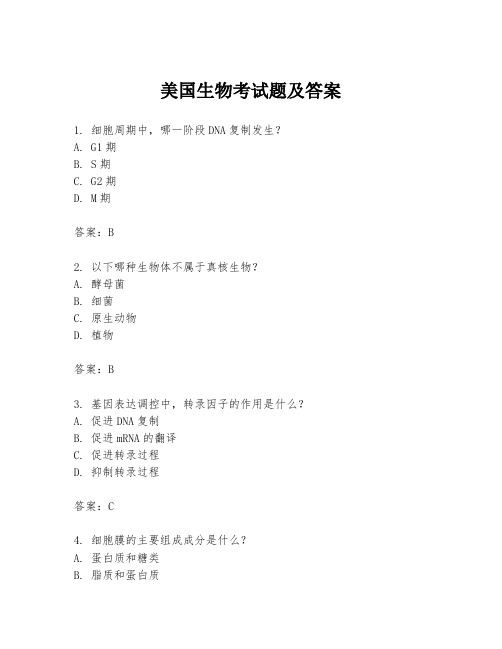
美国生物考试题及答案1. 细胞周期中,哪一阶段DNA复制发生?A. G1期B. S期C. G2期D. M期答案:B2. 以下哪种生物体不属于真核生物?A. 酵母菌B. 细菌C. 原生动物D. 植物答案:B3. 基因表达调控中,转录因子的作用是什么?A. 促进DNA复制B. 促进mRNA的翻译C. 促进转录过程D. 抑制转录过程答案:C4. 细胞膜的主要组成成分是什么?A. 蛋白质和糖类B. 脂质和蛋白质C. 脂质和糖类D. 蛋白质和核酸答案:B5. 以下哪个过程不涉及细胞呼吸?A. 糖酵解B. 三羧酸循环C. 电子传递链D. 光合作用答案:D6. 人体中,哪种激素主要负责调节血糖水平?A. 胰岛素B. 生长激素C. 甲状腺素D. 肾上腺素答案:A7. 在孟德尔遗传定律中,分离定律描述了什么?A. 基因在染色体上的线性排列B. 基因在形成配子时的分离C. 基因在细胞分裂时的复制D. 基因在受精时的组合答案:B8. 以下哪种生物过程不涉及DNA的复制?A. 细胞分裂B. DNA修复C. 转录D. 逆转录答案:C9. 线粒体和叶绿体共同具有的结构特征是什么?A. 双层膜结构B. 自我复制能力C. 核糖体的存在D. 含有DNA答案:D10. 以下哪种生物技术不涉及基因的直接操作?A. 基因敲除B. 基因编辑C. 基因克隆D. 蛋白质工程答案:D11. 人类基因组计划的主要目标是什么?A. 确定人类基因组中的所有基因B. 绘制人类基因组的物理图谱C. 确定人类基因组中的所有序列D. 研究人类基因的表达调控答案:C12. 以下哪种物质不是细胞信号分子?A. 激素B. 神经递质C. 细胞因子D. 脂质答案:D13. 在生态系统中,生产者主要指的是什么?A. 消费者B. 分解者C. 初级消费者D. 光合作用生物答案:D14. 以下哪种生物技术可以用于疾病诊断?A. PCRB. DNA测序C. 基因克隆D. 蛋白质工程答案:A15. 以下哪种生物过程不涉及细胞死亡?A. 细胞凋亡B. 细胞坏死C. 细胞分裂D. 细胞分化答案:C。
美国生物考试题目及答案

美国生物考试题目及答案1. 描述细胞周期的各个阶段,并解释它们在细胞分裂过程中的作用。
答案:细胞周期包括间期(G1、S、G2)和有丝分裂期(M)。
间期是细胞生长和DNA复制的阶段,有丝分裂期则包括前期、中期、后期和末期,这些阶段确保染色体被平均分配到两个新细胞中。
2. 解释DNA复制过程中的半保留复制机制。
答案:DNA复制是半保留的,意味着每个新合成的DNA分子由一个原始链和一个新合成的互补链组成。
这种机制确保了遗传信息的准确传递。
3. 列出三种主要的植物激素,并简述它们的主要功能。
答案:植物激素包括生长素、赤霉素和脱落酸。
生长素主要负责细胞伸长和分化;赤霉素促进细胞伸长和分裂;脱落酸则参与植物的休眠和衰老过程。
4. 阐述线粒体和叶绿体在细胞能量转换中的作用。
答案:线粒体是细胞的能量工厂,通过氧化磷酸化过程产生ATP,为细胞活动提供能量。
叶绿体则在光合作用中将光能转化为化学能,储存在葡萄糖等有机物中。
5. 描述孟德尔遗传定律中的分离定律和自由组合定律。
答案:分离定律指出在生殖细胞形成过程中,等位基因会分离,每个生殖细胞只获得一个等位基因。
自由组合定律则说明不同基因座上的等位基因在形成生殖细胞时是独立分离的,互不影响。
6. 简述内环境稳态的概念及其重要性。
答案:内环境稳态指的是体内环境的化学成分和物理条件保持相对稳定的状态。
这种稳态对于维持生命活动至关重要,因为它确保了细胞和器官能在最佳条件下运作。
7. 描述光合作用中光反应和暗反应的过程及其相互关系。
答案:光反应发生在叶绿体的类囊体膜上,通过光能激发电子,产生ATP和NADPH。
暗反应则在叶绿体的基质中进行,利用ATP和NADPH将二氧化碳转化为有机物。
光反应为暗反应提供能量和还原力,两者相互依赖。
8. 阐述基因表达调控的基本原理。
答案:基因表达调控涉及多个层面,包括转录前、转录、转录后以及翻译水平的调控。
这些调控机制确保基因在正确的时间和地点以适当的水平表达,从而维持细胞功能和生物体的发育。
生化本科-试卷及答案

⽣化本科-试卷及答案⽣化本科-A 卷及答案(留学⽣) 2012-2013学年第⼀学期《Biochemistry and molecular biology 》课程考试卷(A 卷)专业:Clinical medicine 层次:undergraduate course 年级:2011(total points :100分,test time :120mins ,试题内容5页,空⽩纸4页)The department director :Objective questions:⼀、Single choice questions (1 point each,total 33points. Directions: Each of the questions below is followed by five suggested answers or completions. Select the one that is best in each case and then completely fill in the corresponding space on the answer sheet.)1、 Which pair of amino acids absorbs themost UV light at 280 nm? A, Thr & His.B, Trp & Tyr.C, Cys & Asp.D, Phe & Pro. E, None of the above. 2、 The deficiency of which one leads to Beriberi. A. vitamin B1 B. vitamin PP C. vitamin B2 D. vitamin E E. folic acid 3、 Holoenzyme refers to A. complex of enzyme and substrate B. complex of enzyme and inhibitor C. complex of apoenzyme and cofactor D. inactive precursors of enzyme E. complex of enzyme and allosteric effector 4、 Competitive inhibitor competes with the substrate molecules for binding to the A. ES complex B. a site other than the active site C. active site of the enzyme D. substrate E. subunit5、 directly participate in the making and breaking of bonds, catalyzing substrate to products.A. binding groupsB. catalytic groupsC. alkaline groupsD. acidic groupsE. hydrophobic groups 6、 Which of the following statements about the salvage pathway for the synthesis of purine nucleotides is correct? A.Increased PRPP levels in cells inactivate hypoxanthine-guanine phosphoribosyl transferase (HGPRT). B 、Decreased PRPP levels in cells lead to the activation of hypoxanthine-guanine phosphoribosyl transferase (HGPRT). C 、Increased PRPP levels in cells lead to the activation of hypoxanthine-guanine phosphoribosyl transferase (HGPRT). D 、Purine nucleotides competitivelyinhibit hypoxanthine-guanine phosphoribosyl transferase (HGPRT). E 、Salvage pathway is the major way to synthesize purine nucleotides in all tissue姓名:______年级:专业:班别:学号:□□□□□□□□□□7、Which of the following statements aboutthe de novo synthesis of purinenucleotides is correct?A、AMP is the first purine nucleotide assembled from the de novo pathway.B、The enzyme PRPP amidotransferase catalyses the committed step of the de novo synthesis pathway.D、AMP is a competitive inhibitor of PRPP amidotransferase.E、GMP is the first purine nucleotideassembled from the de novo pathway.8、An RNA-dependent RNA polymerase islikely to be present in the virion of aA DNA virus that multiplies in the cytoplasmB DNA virus that multiplies in the nucleusC minus-strand RNA virusD plus-strand RNA virusE transforming virus9、Eukaryotic cells with DNA damage oftencease progression through the cell cycleuntil the damageis repaired. This type ofcontrol over the cell cycle is referred toasA proteosome controlB damage controlC checkpoint controlD anticyclin control10、Consider the average in vivo turnoverrates for proteins,DNA, and mRNA.Which of the following orders bestdescribes the turnover rate from fastest(shortest average lifetime) to slowest(longest average lifetime)?A mRNA > DNA > proteinsB mRNA > proteins > DNAC Proteins > mRNA > DNAD Proteins > DNA > mRNAEDNA > mRNA > proteins11、Which one is most unstable below: A.DNA double strand B.RNA hairpin C.C/G D.A/T E.A/U12、The principal site of peptideneurohormone biosynthesis is the AnucleusB rough endoplasmic reticulumD postsynaptic densityE synaptic vesicle13、The K m (Michaelis constant) of anenzyme for a substrate is definedoperationally asA half the substrate concentration at which the reaction rate is maximalB the substrate concentration at which the reaction rate is half maximalC the dissociation constant of the enzymesubstrate complexD the dissociation constant of the enzymeproduct complexE the rate constant of the reaction at saturation14、Which of the following types ofmolecules is always found in virions?A LipidB ProteinC CarbohydrateD DNAE NA15、If the sense sequence is5'-ACTACTCAG3',the complementarymRNA should be :A.5'-TGATCAGTC-3'B.5'-UGAUGAGUC-3'C.5'-CUGAGUAGU-3'D.5'-CTGAGTAGT-3'E.5'-CAGCUGACU-3'16、RNA synthetized by Eukaryotic RNApolymarase Ⅱ is:A.rRNA B.hnRNA C.tRNAD.5SRNAE.18SRNA17、DNA dependent RNA polymarase iscomposed of several subunits. The coreenzyme is:A. ααββ'C. ααβ'D. ααβE. αββ'18、The enzyme for transcription is :A. DNA dependent RNA polymarase (DDRP)B.RNA dependent DNA polymarase (RDDP)C.DNA dependent DNA polymarase (DDDP)D.RNA dependent RNA polymarase (RDRP)E.Primase19、Which one below can transfer DNAgenetic information to protein?A. tRNA B.mRNA C. rRNA D.hnRAN E.AA20、The stop codon are :A.AUG AGU AGG B.UAG UGA UAA C.AUG AGU AUUD.UAG UGA UGG E.GAU GUA GAA 21、The sedimentation coefficient of the eukaryotic ribosome is:A. 40S + 60S=80S B.30S +50S=80S C. 40S + 60S=100S D.30S + 50S=70S E 50S + 20S=70S22、The main antioxidation in red blood cellsis:A. GSHB. NAD+C. NADP+D. FADE. FMN23、The secondary structure is a regularlyrepeating structure such as:A. Collagen helixB. Disulfide bondC. -helixD. DomainsE. All of the above24、Aspartic acid is similar to glutamic acidin the same way thatB. Ser is similar to Cys.C. Gln is similar to AsnD. Asn is similar to Gln.E. Gly is similar to Val.25、Amino acids in protein belonging to which of following? A. L-β-amino acidsB. D-β-amino acidsC. L-α-amino acidsD. D-α-amino acidsE. L,D-α-amino acids26、Nucleic acids generally doesn't contain ()A .carbonB .hydrogenC. sulfurD. oxygenE .nitrogen27、The RNA complementary strand of DNA5’-CGGTA-3’ is:A.5’-GCCTA-3’B.5’-GCCAU-3’C.5’-UACCG-3’D.5’-TAGGC-3’E.5’-TUCCG-3’28、The Cori cycle describes the release of lactate from active muscle into the bloodstream and its subsequent uptakeby the liver. The lactate in the liver isthen used for:A. Glycogen synthesisB. ATP phosphorylationC. Phosphocreatine synthesisD. Glucose synthesisE. Alanine synthesisof the electron transport chain are locatedin theA. CytosolB. outer mitochondrial membrane.C. intermembrane space.D. inner mitochondrial membrane.E. mitochondrial matrix.30.Oxidation of palmitic acid (C16) involves ___ rounds of β-oxidation and yields ___ molecules of acetyl-CoA.A. 8, 8B. 7, 8C. 16, 8D. 7, 7E. 16, 731.Ras proto-oncogene is converted into oncogene byA. A point mutationB. Chromosomal translocationC. Insertion of a viral promoter upstream of the geneD. Gene amplificationE. Gene deletion32.Retinoblastoma can result from a mutation inA. Ras proto-oncogeneB. erbB proto-oncogeneC. p53 geneD RB geneE. c-myc gene 33.The only correct statement about oncoviruses isA. All the oncoviruses are RNA virusesB. Reverse transcriptase is present in all oncovirusesC. All the oncoviruses are DNA virusesD. Viral oncogenes are identical to human proto-oncogenesE. Both DNA and RNA can be oncoviruses⼆、Multiple choice questions(1 point each,total 3points)34.The most common structural feature of the DNA binding domain includes:A. helix-turn-helix motifB. zinc finger motifD. nucleolusE. cytoplasm35.Protein secondary structure including ( ) A.α-helix B.random coilC.β-pleated cheetD.β-turnE.subunit36.Antimetabolites of nucleotides include:A、Folic acid analogsB、Purine analogsC、Amino acid analogsD、Nucleoside analogsE、Pyrimidine analogsSubjective questions⼀、1. Domain2. HDL3、HMG-CoA reductase4、G-protein5、DNA replication6、codon⼆、brief answers(6 points each,total 24 )1.What is the primary structure of protein? What kind of bond hold the structure?2、Please tell the DNA double helix model3、Why the liver can supple blood glucose?4.What are included in the Protein Synthetic System?三、essay questions(11 points each,total 22)5、What is beta-oxidation? What is the key enzyme? Please calculate how many NADH, FADH2 and acetyl-CoA will be generated by a 16 carbon fatty acid after comply oxidize by beta-oxidation.6. Which mechanism can ensure the Fidelity of DNA replication?《Biochemistry and molecular biology》课程考试卷(A卷)专业:Clinical medicine层次:undergraduate course年级:2011(total points:100分,test time:120mins)suggested answers or completions. Select the one that is best in each case and then completely fill in the corresponding space on the answer sheet1.B2.A3.C4.C5.B6.C7.B8.C9.C 10.B 11.E 12B 13 B 14.B 15.C 16.B17.A 18 A 19 B 20 B 21 A 22A 23 C 24 D 25 C 26 C 27 C 28 D 29 D 30B 31 A 32D 33E 34 ABC 35ABCDE 36ABCDE⼆、Explanation of Terms(3points each,total 18 points)1.Subunit在四级结构的蛋⽩质分⼦中含有⼆条或⼆条以上的多肽链,其中每条都具有完整的三级结构,称为蛋⽩质的亚基。
国外生物考试试题及答案

国外生物考试试题及答案一、选择题(每题2分,共20分)1. 细胞膜的主要功能是什么?A. 储存遗传信息B. 保护细胞内部结构C. 进行能量转换D. 合成蛋白质答案:B2. 以下哪种生物体不属于真核生物?A. 酵母菌B. 细菌C. 原生动物D. 植物答案:B3. 光合作用中,光能被转化为哪种能量?A. 热能B. 电能C. 化学能D. 机械能答案:C4. 以下哪种激素是由胰腺产生的?A. 胰岛素B. 甲状腺素C. 肾上腺素D. 促性腺激素答案:A5. 人类的染色体数量是多少?A. 22对B. 23对C. 24对D. 25对答案:B6. DNA复制过程中,哪种酶负责解开双螺旋结构?A. 聚合酶B. 连接酶C. 解旋酶D. 限制酶答案:C7. 以下哪种生物过程不涉及细胞分裂?A. 胚胎发育B. 组织修复C. 细胞分化D. 细胞衰老答案:D8. 以下哪种生物体属于原核生物?A. 真菌B. 原生动物C. 细菌D. 植物答案:C9. 以下哪种物质是细胞呼吸过程中的最终电子受体?A. 氧气B. 二氧化碳C. 水D. 葡萄糖答案:A10. 以下哪种生物体不属于病毒?A. 噬菌体B. 朊病毒C. 流感病毒D. 酵母菌答案:D二、填空题(每题2分,共20分)1. 细胞核内的遗传物质是______。
答案:DNA2. 细胞膜主要由______和______组成。
答案:磷脂、蛋白质3. 光合作用中的光反应发生在______。
答案:类囊体膜4. 人类的性别决定方式是______。
答案:XY型5. 细胞周期包括______、S期、G2期和M期。
答案:G1期6. 真核细胞中,蛋白质合成的主要场所是______。
答案:核糖体7. 细胞凋亡是由______控制的程序性细胞死亡。
答案:基因8. 人类基因组计划的目的是测定人类______条染色体上的DNA序列。
答案:239. 细胞呼吸的最终产物是______和水。
答案:二氧化碳10. 酶的催化作用依赖于其______。
美国生物学试题及答案
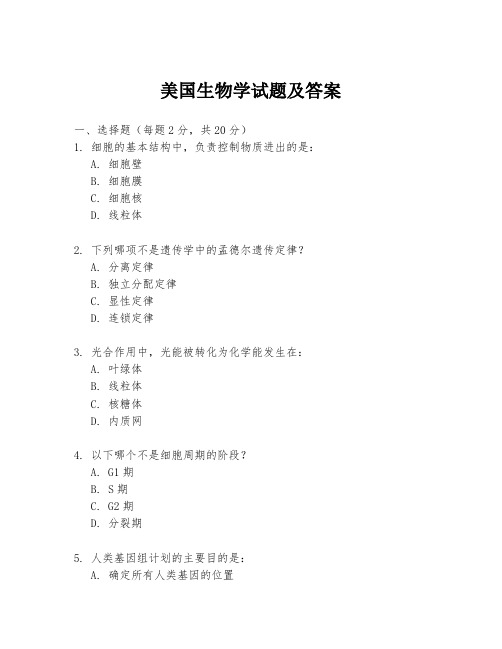
美国生物学试题及答案一、选择题(每题2分,共20分)1. 细胞的基本结构中,负责控制物质进出的是:A. 细胞壁B. 细胞膜C. 细胞核D. 线粒体2. 下列哪项不是遗传学中的孟德尔遗传定律?A. 分离定律B. 独立分配定律C. 显性定律D. 连锁定律3. 光合作用中,光能被转化为化学能发生在:A. 叶绿体B. 线粒体C. 核糖体D. 内质网4. 以下哪个不是细胞周期的阶段?A. G1期B. S期C. G2期D. 分裂期5. 人类基因组计划的主要目的是:A. 确定所有人类基因的位置B. 测序所有人类基因C. 确定所有基因的功能D. 以上都是二、填空题(每空1分,共10分)6. 细胞分裂的两种类型是________和有丝分裂。
7. 基因突变是指基因序列发生________变化。
8. 酶是生物催化剂,它们________于加速化学反应的速率。
9. 染色体是由DNA和________组成的。
10. 人类常见的血型系统是ABO血型系统,它包括A型、B型、AB型和________型。
三、简答题(每题10分,共30分)11. 简述达尔文的自然选择理论。
12. 解释什么是克隆技术及其在医学中的应用。
13. 描述细胞凋亡的过程及其在生物体中的作用。
四、论述题(每题15分,共30分)14. 论述基因编辑技术CRISPR-Cas9的原理及其潜在的伦理问题。
15. 讨论生态系统中物种多样性的重要性以及保护生物多样性的措施。
五、实验设计题(10分)16. 设计一个实验来验证光合作用需要光。
请描述实验的步骤、预期结果和可能的变量。
答案:一、选择题1. B2. C3. A4. D5. D二、填空题6. 无丝分裂7. 变异8. 作用9. 蛋白质10. O型三、简答题11. 达尔文的自然选择理论认为,在生存斗争中,适应环境的个体更有可能生存下来并繁殖后代,其有利特征会逐渐在种群中积累,导致物种的进化。
12. 克隆技术是指通过人工方法复制生物体或其细胞,医学中可用于治疗疾病、生产药物或器官移植等。
美国生物学试题及答案

美国生物学试题及答案一、选择题(每题2分,共20分)1. 以下哪个选项不是细胞的基本结构?A. 细胞膜B. 细胞核C. 线粒体D. 叶绿体答案:D2. 人类的染色体数量是多少?A. 22对B. 23对C. 24对D. 25对答案:B3. 以下哪个选项不是DNA的主要功能?A. 储存遗传信息B. 催化化学反应C. 指导蛋白质合成D. 复制自身答案:B4. 以下哪个选项是真核细胞和原核细胞共有的结构?A. 细胞壁B. 核糖体C. 线粒体D. 内质网答案:B5. 以下哪个选项是生态系统中的生产者?A. 草B. 羊C. 狼D. 细菌答案:A6. 以下哪个选项是细胞周期的最后一个阶段?A. G1阶段B. S阶段C. G2阶段D. M阶段答案:D7. 以下哪个选项是细胞分裂过程中的有丝分裂?A. 无丝分裂B. 二分裂C. 减数分裂D. 有丝分裂答案:D8. 以下哪个选项是DNA复制过程中的关键酶?A. 逆转录酶B. 限制酶C. DNA聚合酶D. 核酸酶答案:C9. 以下哪个选项是遗传密码中的终止密码?A. UGAB. UGGC. UGCD. UGU答案:A10. 以下哪个选项是细胞凋亡的主要特征?A. 细胞肿胀B. 细胞溶解C. 细胞膜破裂D. 有序的细胞死亡答案:D二、填空题(每题2分,共20分)1. 细胞膜的主要组成成分是__________和__________。
答案:磷脂、蛋白质2. 细胞核的主要功能是__________。
答案:储存和传递遗传信息3. 线粒体的主要功能是__________。
答案:能量转换4. 叶绿体的主要功能是__________。
答案:光合作用5. 真核细胞和原核细胞的主要区别在于__________。
答案:有无核膜包被的细胞核6. 染色体的主要成分是__________和__________。
答案:DNA、蛋白质7. 细胞周期包括__________、__________、__________和__________四个阶段。
美国医师生化考试

I.Fuel MetabolismDirections: Each of the numbered items or incomplete statements in this section is followedby answers or by completions of the statement. Select the one lettered answer or completionthat is best in each case.Questions 1--3A young woman who has a sedentary job and does not exercise consulted a physician abouther weight, which was 110 lb. A dietary history indicates that she eats approximately 100 g of carbohydrate, 20 g of protein, and 40 g of fat daily.1. How many calories (kcal) does this woman consume each day?(A) 1440 (B) 1340 (C) 940 (D) 840 (E) 6402. What is the woman's approximate daily energy expenditure in calories (kcal) per dayat this weight?(A) 1200 (B) 1560 (C) 1800 (D) 2640 (E) 34323.Based on the woman's current weight, diet, and sedentary life-style, the physician correctly concludes that she should(A) increase her exercise level (B) decrease her protein intake(C) increase her caloric intake (D) decrease her fat intake to less than 30% of her total calories4. In the normal adult, the fuel store that conrains the fewest calories is(A) adipose triacylglycerol (B) liver glycogen(C) muscle glycogen (D) muscle protein5. It is more advantageous for the human body to store fuel as triacylglycerol in adiposetissue than as protein in muscle because adipose triacylglycerol stores contain[A) more calories and more water (B) less calories and less water(C) less calories and more water (D) more calories and less water6. Which one of the following amino acids is essential in the human diet?(A) Serine (B) Lysine (C) Glutamate (D) Tyrosine (E) Cysteine7. All of the following statements concerning fuel metabolism are true EXCEPT(A) muscle protein can be a source of fuel for the body(B) negative nitrogen balance occurs when the amount of nitrogen excreted in urineis greater than the amount of nitrogen ingested in the diet(C) dietary protein is not required because amino acids can be synthesized from glucose(D) a person who ingests 100 g of protein/day will excrete about 16 g of nitrogen in the urine8. After fasting for 12 hours, a student consumes a large bag of pretzels. This meal will(A) replenish liver glycogen stores (B) increase the rate of gluconeogenesis(C) reduce the rate at which fatty acids are converted to adipose triacylglycerols(D) increase blood glucagon levels (E) result in glucose being oxidized to lactate by the brainand to CO 2 and H20 by red blood cells9. Which of the following would be observed in a person who is resting after an overnight fast?(A) Liver glycogen stores are completely depleted(B) Liver gluconeogenesis is not an important process(C) Muscle glycogen stores are used to maintain blood glucose(D) Fatty acids are released from adipose triacylglycerol stores(E) The liver is oxidizing ketone bodies to CO 2 and H2010. Which of the following would be observed in a person after i week of starvation?(A) The brain uses glucose and ketone bodies as fuel sources(B) Liver glycogen stores are only partially depleted, due to an increase in gluconeogenesis(C) Nitrogen balance is maintained because muscle protein releases amino acids to compensate for the lack of dietary protein(D) Fatty acids from adipose stores are the major source of fuel for red blood cellsll. When compared to his state after an overnight fast, a person who fasts for 1 week will have (A) higher levels of blood glucose (B) less muscle protein (C) more adipose tissue(D) lower levels of ketone bodies in the blood12. Patients with anorexia nervosa, untreated insulin-dependent diabetes mellitus, hyper- thyroidism, and nontropical sprue all will(A) have a high BMR (B) have high insulin levels in the blood (C) experience weight loss (D) suffer from malabsorption (E) have low levels of ketone bodies in the bloodDirections: Each group of items in this section consists of lettered options followed by a set of numbered items. For each item, select the one lettered option that is most closely associatedwith it. Each lettered option may be selected once, more than once, or not at all.Questions 13-16Match each of the characteristics below with the source of stored energy that it best describes.(A) Protein (B) Triacylglycerols (C) Liver glycogen (D) Muscle glycogen13. The largest form of stored energy in the body14. The energy source reserved for strenuous muscular activity15. The primary source of carbon for maintaining blood glucose during an overnight fast16. The major precursor of urea in the urineQuestions 17-21Match each of the characteristics below with the tissue it best describes.(A) Liver (B) Brain (C) Skeletal muscle (D) Red blood cells17. After a fast of a few days, ketone bodies become an important fuel18. Ketone bodies are used as a fuel after an overnight fast19. Fatty acids are not a significant fuel source at any time20. During starvation, this tissue uses amino acids to maintain levels of blood glucose21. This tissue converts lactate from muscle to a fuel for other tissuesII. Basic Aspects of BiochemistryDirectionsEach of the numbered items or incomplete statements in this section is followed by answers or by completions of the statement. Select the one lettered answer or completion that is best in each case.7. When the pH for a solution of this acid is equal to the pK, the ratio of the concentrations of the salt and the acid ([A-]/[HA]) is(A) 0 (B) 1 (C) 2 (D) 3 (E) 48. Proteins are effective buffers because they contain(A) a large number of amino acids (B) amino acid residues with different pKs(C) N-terminal and C-terminal residues that can donate and accept protons(D) peptide bonds that readily hydrolyze, consuming hydrogen and hydroxyl ions(E) a large number of hydrogen bonds in a-helicesQuestions 9 and 10Use the structure to answer questions 9 and 10:Asp-Ala-Ser-Glu-Val-Arg9. The C-terminal amino acid of the hexapeptide shown is(A) alanine (B) asparagine (C) aspartate (D) arginine10. At physiologic pH (7.4), this hexapeptide will contain a net charge of(A) -2 (B) -1 (C) 0 (D) +1 (E) +211. Which one of the following types of bonds is covalent?(A) Hydrophobic (B) Hydrogen (C) Disulfide (D) Electrostatic12.In sickle cell anemia, the hemoglobin molecule (HbS) is abnormal. If the β•chains of normal hemoglobin (HbA) and HbS have the N-terminal sequences shown below and the chains otherwise are the same, which of the following statements is TRUE?HbA Val-His-Leu-Thr-Pro-Glu-Glu-Lys-Ser-Ala-Val-Thr...HbS Val-His-Leu-Thr-Pro-Val-Glu-Lys-Ser-Ala-Val-Thr...(A) HbS contains one more hydrophobic amino acid than HbA(B) HbS contains one more negative charge than HbA(C) Neither HbS nor HbA contains an amino acid that has a side chain with a pK of 6(D) The entire sequences shown for both HbA and HbS can form a-helices13. Which one of the following conditions causes hemoglobin to release oxygen more readily?(A) Metabolic alkalosis(B) Increased production of 2,3-bisphosphoglycerate (BPG)(C) Hyperventilation, leading to decreased levels of CO 2 in the blood(D) Replacement of theβsubunits with γsubunits14. Production of which of the following proreins would be most directly affected in scurvy?(A) Myoglobin (B) Collagen (C) Insulin (D) Hemoglobin15. The active site of an enzyme(A) is formed only after addition of a specific substrate(B) is directly involved in binding of allosteric inhibitors(C) resides in a few adjacent amino acid residues in the primary sequence of the polypeptide chain(D) binds competitive inhibitors16. An enzyme catalyzing the reaction E + S = ES →E + P was mixed with 4 mM substrate. The initial rate of product formation was 25% of Vm. The Km for the enzyme is(A) 2 mM (B) 4 mM (C) 9 mM (D) 12 inM (E) 25 mM17. The velocity (v) of an enzyme-catalyzed reaction(A) decreases as the substrate concentration increases(B) is lowest when the enzyme is saturated with substrate(C) is related to the substrate concentration at lh Vm(D) is independent of the pH of the solutionQuestions 18 and 19Refer to the following reaction when answering questions 18 and 19.Fumarate + H20 •↔ malatefumarase18. Fumarase catalyzes the conversion of fumarate to malate. It has a K m of 5 μM for fumarate and a V max of 50 μmol/min/mg of protein when measured in the direction of malate formation. The concentration of fumarate required to give a velocity of 25 μmol/min/mg protein is(A) 2 μM (B) 5 μM (C) 10 μM (D) 20 μM (E) 50 μM19.The Km for fumarase is approximately 5 μM for fumarate. The fumarate concentration in mitochondria is approximately 2 mM. If the fumarate concentration dropped to 1 mM, the reaction rate would(A) increase slightly (B) decrease slightly(C) decrease by one half (D) stay exactly the same20.Hexokinase and glucokinase both catalyze the phosphorylation of glucose to glucose 6-phosphate. The values of K m for the enzymes are 10 μM and 0.02 M, respectively. If blood glucose is 5 mM under fasting conditions and 20 mM after a high-carbohydrate meal(A) hexokinase will function near its V max• under fasting conditions(B) glucokinase will function near its V max under fasting conditions(C) hexokinase will function at less than one-half V max after a high-carbohydrate meal(D)glucokinase will function at less than one-half V max after a high-carbohydrate meal21. A competitive inhibitor of an enzyme(A) increases Km but does not affect Vmax•(B) decreases Km but does not affect Vmax(C) increases Vmax• but does not affect Km(D) decreases Vmax• but does not affect Km(E) decreases both Vmax• and KmQuestions 22-25Refer to the graph when answering questions 22-25.22. The value of Km for the enzyme depicted by curve A is(A) 0.5 mM (B) 1 mM (C) 2 mM (D) 1 μmol/min/mg (E) 10 μmol/min/mg23. The value of Vm for the enzyme depicted by curve A is(A) 0.1 μmol/min/mg (B) 1 μmol/min/mg(C) 10 μmol/min/mg (D) 0.5 mM (E) 2 mM24.Curve B depicts the effect of an inhibitor on the system described by curve A. This inhibitor(A) is a competitive inhibitor (B) is a noncompetitive inhibitor(C) increases the Vmax (D) decreases the Km•25. Curve C depicts the effect of a different inhibitor of the system described by curveA. This second inhibitor(A) is a competitive inhibitor(B) is a noncompetitive inhibitor(C) increases the Vmax•(D) decreases the Km•Directions: Each group of items in this section consists of lettered options followed by a set of numbered items. For each item, select the one lettered option that is most closely associated with it. Each lettered option may be selected once, more than once, or not at all.Questions 33-37Match each characteristic below with the protein it best describes.(A) Hemoglobin (B) Myoglobin (C) Collagen (D) Insulin33. Requires vitamin C for its synthesis34. Has one oxygen binding site and one polypeptide chain35. Contains four molecules of heine per molecule of protein36. Is converted into a triple helix during its synthesis37. Is composed of two polypeptide chains joined by disulfide bondsIII. DNA and RNADirections: Each of the numbered items or incomplete statements in this section is followedby answers or by completions of the statement. Select the one lettered answer or completionthat is best in each case.1. In DNA, on a molar basis(A) adenine equals thymine (B) adenine equals uracil (C) guanine equals adenine(D) cytosine equals thymine (E) cytosine equals uracil2. Which of the following sequences is complementary to the DNA sequence 5'-AAGTCCGA-3'?(A) 5'-AAGUCCGA-3' (B) 3'-TTCAGGCT-5' (C) 5'-TTCAGGCT-3' (D) 3'-TCGGACTT-5'3. DNA contains which one of the following components?(A) Nitrogenous bases joined by phosphodiester bonds(B) Negatively charged phosphate groups in the interior of the molecule(C) Base pairs stacked along the central axis of the molecule(D) Two strands that run in the same direction(E) The sugar ribose4. Which RNA contains 7-methylguanine at the 5' end?(A) 5S RNA (B) rRNA (C) hnRNA (D) tRNA5. Thymine is present in which type of RNA?(A) mRNA (B) rRNA (C) hnRNA (D) tRNAIV. Generation of ATP from Metabolic FuelsDirections: Each of the numbered items or incomplete statements in this section is followedby answers or by completions of the statement. Select the one lettered answer or completionthat is best in each case.5. Of the total energy available from the oxidation of acetate, what percentage is transferredvia the TCA cycle to NADH, FADH2, and GTP?(A) 38% (B) 42% (C) 82% (D) 86% (E) 100%6. What percentage of the energy available from the oxidation of acetate is converted to ATP?(A) 3% (B) 3O% (C) 4O% (D) 85% (E) 100%7. If the enzyme concentration for a biochemical reaction is increased 100-fold, the equilibrium constant for the reaction will(A) decrease twofold (B) remain the same (C) increase in proportion to the enzyme concentration(D) change inversely with the enzyme concentration8. All of the following are electron carriers in the electron transport chain EXCEPT(A) cytochromes (B) coenzyme Q (C) Fe-S centers (D) hemoglobin (E) riboflavin9. In the tricarboxylic acid cycle, thiamine pyrophosphate(A) accepts electrons from the oxidation of pyruvate and α-ketoglutarate(B) accepts electrons from the oxidation of isocitrate(C) forms a covalent intermediate with theα-carbon of α-ketoglutarate(D) forms a thioester with the sulfhydryl group of CoASH(E) forms a thioester with the sulfhydryl group of lipoic acid10. Each of the following vitamins is required for reactions in the oxidation of pyruvate toCO2 and H20 EXCEPT(A) pantothenate (B) niacin (C) thiamine (D) biotin (E) riboflavin12. The reactions of the TCA cycle oxidizing succinate to oxaloacetate(A) require coenzyme A (B) include an isomerization reaction(C) produce one high-energy phosphate bond (D) require both NAD+ and FAD(E) produce one GTP from GDP + Pi13. Each of the following statements concerning pyruvate dehydrogenase is true EXCEPT(A) it is an example of a multienzyme complex(B) it requires thiamine pyrophosphate as a cofactor(C) it produces oxaloacetate from pyruvate(D) it is converted to an inactive form by phosphorylation(E) it is inhibited when NADH levels increase14. The principl function of the TCA cycle is to(A) generate CO2(B) transfer electrons from the acetyl portion of acetyl CoA to NAD+ and FAD(C) oxidize the acetyl portion of acetyl CoA to oxaloacetate(D) generate heat from the oxidation of the acetyl portion of acetyl CoA(E) dispose of excess pyruvate and fatty acids15. During exercise, stimulation of the TCA cycle results principally from(A) allosteric activation of isocitrate dehydrogenase by increased NADH(B) allosteric activation of fumarase by increased ADP(C) a rapid decrease in the concentration of four-carbon intermediates(D) product inhibition of citrate synthase(E) stimulation of the flux through a number of enzymes by a decreased NADH/NAD+ ratio16. CO2 production by the TCA cycle would be increased to the greatest extent by a geneticabnormality that resulted in(A) a 50% increase in the concentration of ADP in the mitochondrial matrix(B) a 50% increase in the oxygen content of the cell(C) a 50% decrease in the Vm of a-ketoglutarate dehydrogenase(D) a 50% increase in the Km of isocitrate dehydrogenase17. A man presents to the emergency department after ingesting an insecticide. His respiration rate is very low. Information from the Poison Control Center indicates that this particular insecticide binds to and completely inhibits cytochrome c. Therefore, in this man's mitochondria(A) coenzyme Q would be in the oxidized state(B) cytochromes a and a 3 would be in the reduced state(C) the rate of ATP synthesis would be approximately zero(D) the rate of CO2 production would be increased18. Which one of the following statements best describes the consequence of ingesting a compound that stimulates ATP hydrolysis by plasma membrane Na+-K+ ATPase?(A) The pH gradient across the mitochondrial membranes would increase(B) The rate of conversion of NADH to NAD+ in the mitochondria would decrease(C) Heat production would decrease(D) The transfer of electrons to 02 would increase19. A chemist wanting to lose weight obtained dinitrephenol (DNP). Before using the DNP, the chemist consulted her physician and was informed that DNP was an uncoupling agent andwas dangerous to use for weight loss. Which of the following changes would have occurredin her mitochondria if she had ingested enough DNP?(A) O2 consumption would decrease(B) CO2 production would decrease(C) The proton gradient would increase(D) NADH would be oxidized more rapidly(E) Temperature would decreaseDirections: Each group of items in this section consists of lettered options followed by a set of numbered items. For each item, select the one lettered option that is most closely associatedwith it. Each lettered heading may be selected once, more than once, or not at all.Questions 20-24Match each cofactor with the vitamin that is required for its synthesis.(A) Riboflavin (B) Pantothenic acid (C) Niacin (D) Vitamin B620. NAD+21. FAD 22. Coenzyme A 23. FMN 24. Pyridoxal phosphateQuestions 25-28Match each process with the appropriate vitamin.(A) Vitamin A (B) Vitamin C (C) Vitamin D (D) Vitamin K25. Blood clotting 26. Calcium metabolism 27. Collagen synthesis 28. VisionQuestions 34-38Match each enzyme below with the vitamin or vitamins required for its activity.(A) Thiamine (B) Niacin (C) Thiamine and niacin (D) Neither thiamine nor niacin34. Pyruvate dehydrogenase35. Malate dehydrogenase36. Pyruvate carboxylase37. a-Ketoglutarate dehydrogenase38. Succinate dehydrogenaseQuestions 39-42Match each item below with the appropriate enzyme or enzymes.(A) Isocitrate dehydrogenase(B) Malate dehydrogenase(C) Both isocitrate and malate dehydrogenase(D) Neither dehydrogenase39. Regulated allosterically by ADP40. Liberates CO241. Reduces a cofactor that transfers electrons to the electron transport chain42. Utilizes FAD as a cofactorV. Carbohytrate MetabolismDirections: Each of the numbered items or incomplete statements in this section is followedby answers or by completions of the statement. Select the one lettered answer or completionthat is best in each case.3. After digestion of a piece of cake that contains flour, milk, and sucrose as its primary ingredients, the major carbohydrate products entering the blood are(A) glucose (B) fructose and galactose (C) galactose and glucose(D) fructose and glucose (E) glucose, fructose, and galactose4. A patient has a genetic defect that causes intestinal epithelial cells to produce disaccharidases of much lower activity than normal. Compared to a normal person, after eating a bowl of milk and oatmeal, this patient will have higher levels of(A) maltose, sucrose, and lactose in the stool (B) starch in the stool(C) galactose and fructose in the blood (D) glycogen in the muscles (E) insulin in the blood5. The degradation of glycogen normally produces(A) more glucose than glucose l-phosphate(B) more glucose 1-phosphate than glucose(C) equal amounts of glucose and glucose 1-phosphate(D) neither glucose nor glucose l-phosphate(E) only glucose l-phosphate6. Which of the following statements about liver phosphorylase kinase is true?(A) It is present in an inactive form when epinephrine is elevated(B) It phosphorylates phosphorylase to an inactive form(C) It catalyzes a reaction that requires ATP(D) It is phosphorylated in response to elevated insulin(E) It is not affected by cAMP7. A patient had large deposits of liver glycogen, which, after an overnight fast, had shorterthan normal branches. This abnormality could be caused by(A) a deficiency of phosphorylase(B) a defect in the glucagon receptor(C) an inability to produce glycogenin(D) a deficiency of amylo-l,6-glucosidase (a-glucosidase)(E) a genetic deficiency of amylo-4,6-transferase (4:6 transferase)8. In which compartment of the cell does glycolysis occur?(A) Mitochondrion (B) Nucleus (C) Soluble cytoplasm (cytosol)(D) Rough endoplasmic reticulum (E) Smooth endoplasmic reticulum9. How many net molecules of ATP are generated in the conversion of glucose to pyruvate?(A) 0 (B) 1 (C) 2 (D) 3 (E) 410. What type of bond is formed between phosphate and carbon 1 of 1,3-bisphosphoglycerate?(A) Anhydride (B) Ester (C) Phosphodiester (D) Amide (E) Ether12. Which of the following statements about glycolysis is TRUE?(A) Glucokinase catalyzes the conversion of glucose to glucose 6-phosphate in the liver(B) Phosphofructokinase 1 catalyzes the conversion of fructose 1,6-bisphosphate to dihydroxyacetone phosphate(C) When one molecule of glucose is convetted to pyruvate via glycolysis, onemolecule of NAD ч is reduced(D) When one molecule of glucose is converted to pyruvate via glycolysis, one carbon is lost as CO2(E) Hexokinase catalyzes the conversion of fructose 6-phosphate to fructose 1,6-bisphosphate13. An adolescent patient with a deficiency of muscle phosphorylase was examined while exercising her forearm by squeezing a rubber ball. Compared to a normal person performing the same exercise, this patient(A) could exercise for a longer period of time without fatigue(B) had increased glucose levels in blood drawn from her forearm(C) had decreased lactate levels in blood drawn from her forearm(D) had lower levels of glycogen in biopsies of her forearm muscle14. NADH is required for the one-step reaction by which pyruvate is converted to(A) oxaloacetate (B) acetyl CoA (C) phosphoenolpyruvate (D) lactate15. Which of the following is NOT a regulatory mechanism of glycolysis?(A) Activation of phosphofructokinase by AMP(B) Inhibition ofhexokinase by its product(C) Inactivation of pyruvate kinase when glucagon levels are elevated(D) Inhibition of aldolase by fructose 1,6-bisphosphate16. Which of the following glycolytic enzymes is used in gluconeogenesis?(A) Glucokinase (B) Phosphofructokinase 1 (C) Pyruvate kinase (D) Aldolase17. Caffeine inhibits 3',5'-cAMP phosphodiesterase, which converts cAMP to AMP. Whichof the following effects would be observed if cells were treated with caffeine?(A) Decreased activity of liver protein kinase A(B) Decreased activity of muscle protein kinase A(C) Increased activity of liver pyruvate kinase(D) Decreased activity of liver glycogen synthetase18. In the conversion of pyruvate to glucose during gluconeogenesis(A) biotin is required(B) CO2, added in one reaction, appears in the final product(C) energy is utilized only in the form of GTP(D) all of the reactions occur in the cytosol19. In gluconeogenesis, both alanine and lactate are converted in a single step to(A) oxaloacetate (B) acetyl CoA (C) phosphoenolpyruvate (D) pyruvate (E) aspartate20. A common intermediate in the conversion of glycerol and lactate to glucose is(A) pyruvate (B) oxaloacetate (C) malate (D) glucose 6-phosphate (E) phosphoenolpyruvate21. In which of the following compounds do carbons derived from pyruvate leave mitochondria for the synthesis of glucose during fasting?(A) Malate (B) Acetyl CoA (C) Oxaloacetate (D) Lactate (E) Glutamine22. An infant with an enlarged liver has a glucose 6-phosphatase deficiency. This infant(A) cannot maintain blood glucose levels either by glycogenolysis or by gluconeogenesis(B) can use liver glycogen to maintain blood glucose levels(C) can use muscle glycogen to maintain blood glucose levels(D) can convert both alanine and glycerol to glucose to maintain blood glucose levels23. Fructose and galactose enter the liver and are phosphorylated at carbon(A) 1 (B) 2 (C) 3 (D) 5 (E) 624. Dietary fructose is phosphorylated in the liver and cleaved to form(A) two molecules of dihydroxyacetone phosphate(B) one molecule each of dihydroxyacetone phosphate and glyceraldehyde(C) one molecule each of dihydroxyacetone phosphate and glyceraldehyde 3-phosphate(D) one molecule each of dihydroxyacetone and glyceraldehyde 3-phosphate(E) two molecules of glyceraldehyde 3-phosphate25. Which of the following enzymes is not directly required in the sequence of reactionsby which galactose is converted to UDP-glucose?(A) Galactokinase (B) An epimerase (C) Phosphoglucomutase (D) A uridyl transferase26. Which of the following statements concerning lactose synthesis is TRUE?(A) The reactions occur in most tissues(B) a-Lactalbumin acts as a modifier of galactosyl transferase(C) UDP-glucose reacts with galactose(D) UDP-galactose requires dietary galactose for its synthesis27. A pregnant woman who has a lactase deficiency and cannot tolerate milk in her diet is concerned that she will not be able to produce milk of sufficient caloric value to nourish her baby. She should be advised that(A) she must eat pure galactose in order to produce the galactose moiety of lactose(B) she will not be able to breast-feed her baby because she cannot produce lactose(C) the production of lactose by the maremary gland does not require the ingestion of milk ormilk products(D) she can produce lactose by degrading α-lactalbumin28. A mother with a deficiency of galactosyl 1-phosphate uridyl transferase(A) can convert galactose to UDP-glucose for lactose synthesis during lactation(B) can form galactose l-phosphate from galactose(C) can convert galactose to blood glucose(D) can convert galactose to liver glycogen(E) will have lower than normal blood galactose levels after ingestion of milk29. The pentose phosphate pathway generates each of the following products EXCEPT(A) NADPH, which may be used for fatty acid synthesis(B) ribose 5-phosphate, which may be used for the biosynthesis of ATP(C) compounds that are intermediates of glycolysis(D) xylulose 5-phosphate by one of the nonoxidative reactions(E) glucose from ribose 5-phosphate and CO230. In the pentose phosphate pathway, thiamine pyrophosphate is required for the action of(A) an epimerase (B) transaldolase (C) an isomerase(D) transketelase (E) a dehydrogenase •31. The major process responsible for maintaining blood glucose 4 hours after the last meal is(A) glycolysis (B) glycogenolysis (C) the pentose phosphate pathway (D) gluconeogenesis32. The major process responsible for maintaining blood glucose 40 hours after the last meal is(A) glycolysis (B) glycogenolysis (C) the pentose phosphate pathway (D) gluconeogenesis33. The transport of glucose across the cell membrane is stimulated by insulin in(A) brain (B) liver (C) red blood cells (D) skeletal muscle34. Positive allosteric activators of phosphofructokinase i in the liver include(A) ADP (B) acetyl CoA (C) fructose 2,6-bisphosphate (D) ATP (E) citrate35. In an individual at rest who has fasted for 12 hours(A) gluconeogenesis is the major process by which blood glucose is maintained(B) adenyl cyclase is inactivated in liver(C) liver glycogen stores are depleted(D) phosphorylase, pyruvate kinase, and glycogen synthetase are phosphorylated in liver36. When a normal individual in the basal metabolic state ingests a high-carbohydrate meal, there is(A) enhanced glycogen synthetase activity in liver(B) an increased ratio of phosphorylase a to phosphorylase b in liver(C) an increased rate of lactate formation by erythrocytes(D) inhibition of glycogen synthetase phosphatase activity in liver37. An insulin infusion causes blood glucose to decrease because insulin promotes the dephosphorylation of each of the following enzymes EXCEPT(A) liver glycogen phosphorylase (B) liver pyruvate kinase (C) liver glycogen synthetase(D) liver protein kinase A (E) muscle phosphorylase kinase38. A 16-year-old insulin-dependent diabetic patient was admitted to the hospital with a blood glucose of 400 mg/dl. (The reference range for blood glucose is 80-100 mg/dl). One hour after an insulin infusion was begun, her blood glucose had decreased to 320 mg/dl. One hour later, it was 230 mg/dl. The patient's glucose level decreased because insulin(A) stimulates the transport of glucose across the cell membranes of liver and brain(B) stimulates the conversion of glucose to glycogen and triacylglycerol in liver(C) inhibits the synthesis of ketone bodies from blood glucose(D) stimulates glycogenolysis in liver(E) inhibits the conversion of muscle glycogen to blood glucose39. Which of the following statements concerning glycosaminoglycans is TRUE?(A) They contain repeating disaccharides(B) They are usually positively charged(C) They contain short oligosaccharide chains(D) They rarely contain sulfate groups(E) They contain branches of N-acetylneuraminic acid40. Which of the following statements concerning glycoproteins is TRUE?。
美国生物考试题及答案
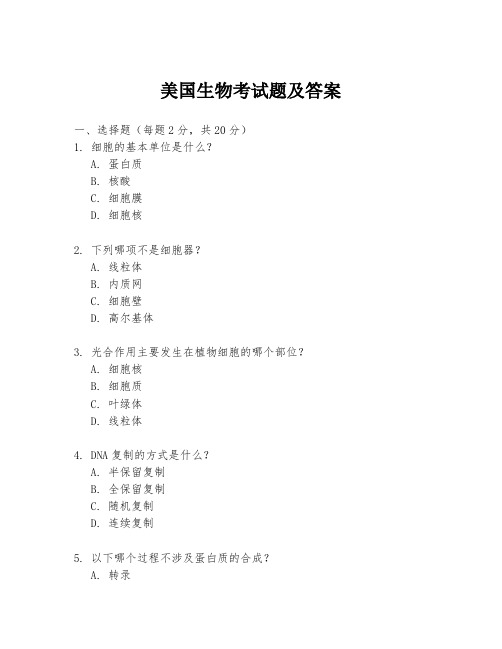
美国生物考试题及答案一、选择题(每题2分,共20分)1. 细胞的基本单位是什么?A. 蛋白质B. 核酸C. 细胞膜D. 细胞核2. 下列哪项不是细胞器?A. 线粒体B. 内质网C. 细胞壁D. 高尔基体3. 光合作用主要发生在植物细胞的哪个部位?A. 细胞核B. 细胞质C. 叶绿体D. 线粒体4. DNA复制的方式是什么?A. 半保留复制B. 全保留复制C. 随机复制D. 连续复制5. 以下哪个过程不涉及蛋白质的合成?A. 转录B. 翻译C. 转译D. 转录后修饰二、填空题(每空2分,共20分)6. 细胞分裂包括两种基本类型:________和________。
7. 遗传信息的传递遵循________定律。
8. 酶是一种________,能够加速化学反应的速率。
9. 人类的染色体总数为________对。
10. 基因突变可能导致________或________。
三、简答题(每题10分,共30分)11. 描述细胞周期的四个阶段,并简要说明每个阶段的主要活动。
12. 解释什么是遗传多样性,并举例说明它在生物进化中的重要性。
13. 阐述孟德尔的遗传定律,并解释它们在现代遗传学中的应用。
四、论述题(每题15分,共30分)14. 讨论基因编辑技术CRISPR-Cas9的原理及其在医学研究中的潜在应用。
15. 分析生态系统中能量流动的特点,并讨论人类活动如何影响这一过程。
答案:一、选择题1. B2. C3. C4. A5. A二、填空题6. 有丝分裂、减数分裂7. 孟德尔遗传8. 生物催化剂9. 2310. 遗传病、进化三、简答题11. 细胞周期包括G1期、S期、G2期和M期。
G1期细胞生长并准备DNA复制;S期DNA复制;G2期细胞继续生长并准备分裂;M期细胞分裂。
12. 遗传多样性是指一个物种内基因型的多样性。
它在生物进化中很重要,因为它提供了适应环境变化的遗传变异,有助于物种的生存和繁衍。
13. 孟德尔的遗传定律包括分离定律和独立定律。
美国生物考试题及答案解析
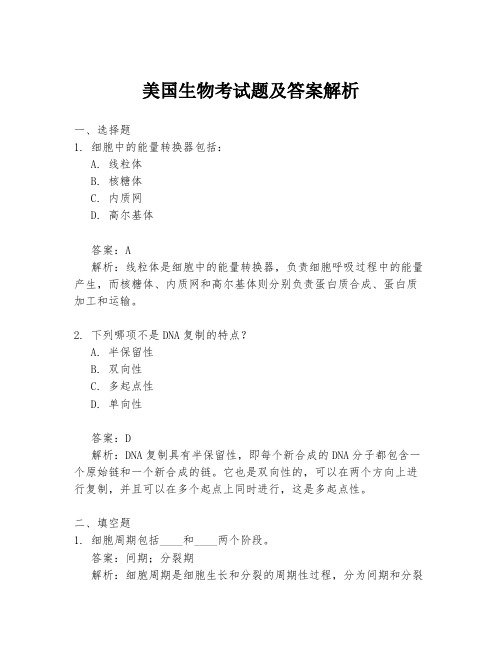
美国生物考试题及答案解析一、选择题1. 细胞中的能量转换器包括:A. 线粒体B. 核糖体C. 内质网D. 高尔基体答案:A解析:线粒体是细胞中的能量转换器,负责细胞呼吸过程中的能量产生,而核糖体、内质网和高尔基体则分别负责蛋白质合成、蛋白质加工和运输。
2. 下列哪项不是DNA复制的特点?A. 半保留性B. 双向性C. 多起点性D. 单向性答案:D解析:DNA复制具有半保留性,即每个新合成的DNA分子都包含一个原始链和一个新合成的链。
它也是双向性的,可以在两个方向上进行复制,并且可以在多个起点上同时进行,这是多起点性。
二、填空题1. 细胞周期包括____和____两个阶段。
答案:间期;分裂期解析:细胞周期是细胞生长和分裂的周期性过程,分为间期和分裂期。
间期是细胞生长和准备分裂的阶段,而分裂期则是细胞实际分裂的阶段。
2. 基因突变是指基因序列发生____的变化。
答案:永久性解析:基因突变是指基因序列发生永久性的变化,这些变化可以是单个核苷酸的替换、插入或缺失,它们可能导致蛋白质结构和功能的改变。
三、简答题1. 描述光合作用的基本过程。
答案:光合作用是植物、藻类和某些细菌将光能转化为化学能的过程。
它主要包括两个阶段:光反应和暗反应。
在光反应中,叶绿体的类囊体膜吸收光能,水分子被分解产生氧气和质子(H+)。
这些质子通过类囊体膜上的ATP合酶,产生ATP和NADPH。
在暗反应中,ATP和NADPH提供能量和还原力,将二氧化碳固定并转化为有机物质,如葡萄糖。
2. 解释什么是遗传多样性,并举例说明其重要性。
答案:遗传多样性是指一个物种内部个体之间基因组成的差异。
这种多样性对于物种的适应性、生存和进化至关重要。
例如,遗传多样性可以增加物种对疾病的抵抗力,因为不同的基因型可能对特定病原体有不同的抗性。
此外,遗传多样性也是农业育种和自然选择的基础,有助于物种适应环境变化。
结束语:通过对美国生物考试题的分析和答案解析,我们可以看到生物学是一门涵盖广泛领域的科学,它不仅包括对生物体结构和功能的研究,还包括对生物体如何适应和进化的深入理解。
美国生物学试题及答案解析
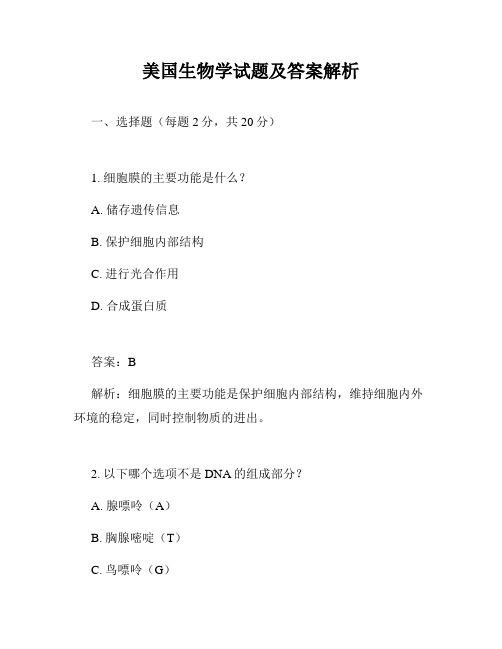
美国生物学试题及答案解析一、选择题(每题2分,共20分)1. 细胞膜的主要功能是什么?A. 储存遗传信息B. 保护细胞内部结构C. 进行光合作用D. 合成蛋白质答案:B解析:细胞膜的主要功能是保护细胞内部结构,维持细胞内外环境的稳定,同时控制物质的进出。
2. 以下哪个选项不是DNA的组成部分?A. 腺嘌呤(A)B. 胸腺嘧啶(T)C. 鸟嘌呤(G)D. 尿嘧啶(U)答案:D解析:DNA的组成部分包括腺嘌呤(A)、胸腺嘧啶(T)、鸟嘌呤(G)和胞嘧啶(C)。
尿嘧啶(U)是RNA的组成部分。
3. 以下哪个选项是真核细胞和原核细胞共有的结构?A. 核糖体B. 线粒体C. 高尔基体D. 内质网答案:A解析:核糖体是真核细胞和原核细胞共有的结构,它们负责蛋白质的合成。
线粒体、高尔基体和内质网是真核细胞特有的结构。
4. 以下哪个选项是植物细胞特有的结构?A. 叶绿体B. 线粒体C. 核糖体D. 内质网答案:A解析:叶绿体是植物细胞特有的结构,负责光合作用。
线粒体、核糖体和内质网是动植物细胞共有的结构。
5. 以下哪个选项是细胞周期的阶段?A. G1期B. S期C. G2期D. 所有选项答案:D解析:细胞周期包括G1期、S期和G2期,这三个阶段是细胞周期的连续阶段,最终导致细胞分裂。
6. 以下哪个选项是孟德尔遗传定律之一?A. 分离定律B. 独立分配定律C. 连锁定律D. 所有选项答案:D解析:孟德尔遗传定律包括分离定律和独立分配定律。
连锁定律是现代遗传学中的一个重要概念,但不是孟德尔提出的定律。
7. 以下哪个选项是生态系统中的能量来源?A. 太阳B. 化学能C. 风能D. 所有选项答案:A解析:在生态系统中,太阳是主要的能量来源,通过光合作用被植物吸收并转化为化学能,进而支持整个生态系统的能量流动。
8. 以下哪个选项是生物进化的证据之一?A. 化石记录B. 比较解剖学C. 分子生物学D. 所有选项答案:D解析:生物进化的证据包括化石记录、比较解剖学和分子生物学等。
- 1、下载文档前请自行甄别文档内容的完整性,平台不提供额外的编辑、内容补充、找答案等附加服务。
- 2、"仅部分预览"的文档,不可在线预览部分如存在完整性等问题,可反馈申请退款(可完整预览的文档不适用该条件!)。
- 3、如文档侵犯您的权益,请联系客服反馈,我们会尽快为您处理(人工客服工作时间:9:00-18:30)。
BCH 4013/6013 Exam 1 (01/31/2012)There are 50 questions worth 0.4 points each (total 20 points)1. Which of the following is NOT a basic element of life?A) PhosporusB) HydrogenC) NitrogenD) OxygenE) All of the above are basic elements of life2. Which of the following classes of compounds make up most of the mass of an organism?A) Amino acidsB) ProteinsC) LipidsD) CarbohydratesE) Water3. A hydrogen bond is best defined as:A) A strong chemical bond between hydrogen and carbonB) A weak chemical bond between hydrogen and carbonC) A bond between two hydrogensD) A weak electrostatic bond between hydrogen and oxygen or nitrogen4. The most important buffer in blood is __________.A) Bicarbonate/carbonic acid bufferB) Protein bufferC) Phosphate bufferD) Lactate buffer5. Consider the following molecule. Which arrow is pointing to a peptide bond?A) AB) BC) CD) D6. Which of the following classes of enzymes catalyze reactions involving the cleavage of bondsby the addition of water?A) TransferaseB) HydrolaseC) LyaseD) Ligase N C C N C C H H H H O H H H O DC7. Consider the following reaction data.Alanylanine + water alanine[alanylanine] [water] Rate0.1 0.1 1x 10-40.2 0.1 2x10-40.1 0.2 2x10-40.2 0.2 4x10-4The reaction is ________ order overall.A ZeroB) FirstC) SecondD) ThirdE) Fourth8. An enzyme without its cofactor is called ________A)CoenzymeB)ApoenzymeC)HoloenzymeD)Isoenzyme9. Which of the following is a function of proteins?A) StructureB) MovementC) TransportD) CatalysisE) All of the above are correct10. The term protein refers to amino acid polymers with greater than ________amino acids.A) 10B) 20C) 50D) 10011. Select the coenzyme that DOES NOT participate in electron transfer reactions.A)NADPB)NADC)ATPD)FAD12. The class of enzyme that catalyzes the following reaction is:A) isomeraseB) ligaseC) hydrolaseD) transferase13. What is the maximum number of hydrogen bonds that one water molecule can have with neighboring water molecules?A) 1B) 2C) 3D) 414. Which of the following amino acids is involved in disulfide bonds?A) cysteineB) methionineC) prolineD) none of above15. An apoenzyme combines with a coenzyme to form aA) holoenzymeB) cofactorC) proenzymeD) prosthetic group16. The alteration of enzyme structure on binding of a substrate to an active site is referred to asA) Enzyme denaturationB) Enzyme inhibitionC) Induced fitD) Enzyme activation17. Which of the following properties is NOT characteristic of enzymes?A) Hold the substrate in close proximityB) Alter the equilibrium constant of the reactionC) Reduce the activation energyD) Often use acid-base catalysis18. Primary protein structure refers toA) overall shape of a proteinB) repeated pattern of foldingC) a protein with multiple subunitsD) linear amino acid sequence19. Which of the following statements about a plot of the initial velocity (V0) vs. the concentration of substrate ([S]) for an enzyme that follows Michaelis-Menten kinetics is FALSE?A)As [S] increases, the initial velocity of reaction V0 also increases.B)At very high [S], the velocity curve becomes a horizontal line that intersects the y-axis at K mC)The shape of the curve is a hyperbolicD) The y-axis is a rate20. Which amino acid is classified as basic?A) prolineB) cysteineC) glutamineD) lysine21. The K m of an enzymatic reaction is equal toA) the concentration of substrate at equilibriumB) the concentration of product at equilibriumC) the concentration of substrate at one-half maximum velocity (V max)D) the concentration of enzyme at one-half maximum velocity (V max)22. In competitive inhibition, an inhibitor:A)binds at several different sites on an enzyme.B)binds covalently to the enzyme.C)binds only to the ES complex.D)binds reversibly at the active site.23. For an enzyme obeying Michaelis-Menten kinetics, what is the V max if V0 = 35 µmole/min when [S] = K m?A) 35 µmole/minB) 70 µmole/minC) 105 µmole/minD) 140 µmole/min24. Secondary protein structure of refers toA) overall shape of a proteinB) repeated pattern of foldingC) a protein with multiple subunitsD) linear amino acid sequence25. The cleft in the surface of an enzyme where a substrate binds is known as:A) modulator siteB) allosteric siteC) active siteD) oligomeric site26. Hydrogen bonds can occur when hydrogen is covalently bonded to atoms like nitrogen and oxygen. What property of nitrogen and oxygen is important for this?A) atomic massB) ionizabilityC) hydrophobicityD) electronegativity27. Succinic acid dehydrogenase is active only in combination with a nonprotein organic molecule called flavin adenine dinucleotide (FAD). FAD is called aA) proenzymeB) isozymeC) apoenzymeD) coenzyme28. The following data were obtained in a study of an enzyme known to follow Michaelis-Menten kinetics:V0 ( mol/min)Substrate added (mM)217 325 433 488 645 650 0.8 246100 1,000The K m for this enzyme is approximately:A)1 mM.B)2 mM.C)4 mM.D)6 mM.29. To what level of structure do α-helices and β-sheets belong?A)Primary structureB)Secondary structureC)Tertiary structureD)Quaternary structure30. According to Henderson-Hasselbalch equation, when theconcentrations of proton acceptor and proton donor are the same, thenA) the carboxylic acid is totally neutralizedB) only salt forms are presentC) pH = pK aD) pK a = log[proton acceptor]/[proton donor]31. The bonds linking amino acids to form proteins are calledA) glycosidic bondsB) hydrogen bondsC) amino bondsD) peptide bonds32. A denaturing agents disrupt the three-dimensional structures of macromolecules byA) breaking glycosidic bondsB) breaking hydrogen bondsC) breaking peptide bondsD) breaking amide bonds33. Allosteric effectors:A) can be very different in structure than the substrates of the enzymeB) typically bind to sites distant from the active site of an enzyme.C) induce a conformational change in the protein to alter its activity.D) All of the above.34. Buffer systems are effective when the pH values are within ___ pH unit(s) of the pK a value.A) 1B) 3C) 4D) 535. The titration curve of the amino acid glycine reveals a pK1 of 2.34, a pI (isoelectric point) of5.97, and a pK2 of 9.60. When dissolved in water, which ionic species is most likely topredominate at pH = 5.97?A) B) C) D)36. Hydrogen bonds between amino acids in a polypeptide occur between which chemical groups?A) the C=O and C-H groupsB) the C=O and C-R groupsC) the C=O groupsD) the C=O and N-H groups37. The pH inside cells is normally near pH 7. At pH 7 which statement is true about the charges (ionization state) of the alfa-carboxyl and alfa-amino groups of an amino aicd?A) The alfa-carboxyl group is 1- and the alfa-amino group is 1+B) The alfa-carboxyl group is 1+ and the alfa-amino group is 1-C) The alfa-carboxyl group is 1- and the alfa-amino group is unchargedD) Both groups are uncharged (not ionized) at pH 738. What is the primary force that stabilizes repeating secondary structures as found in α-helices and β-turns?A) covalent bondsB) ionic interactionsC) hydrogen bondsD) hydrophobic interactions39. The effect of an enzyme is to:A) lower the activation energyB) shift the equilibrium position of the reaction towards productsC) decrease the free energy of the reaction40. What is the isoelectric point, pI, of glycine? Given pKa1=2.3, pKa2=9.6.A) 9.60B) 5.95C) 11.90D) 2.3041. Most enzymes are:A) ProteinsB) LipidsC) DNAD) Carbohydrates42. The chirality of an amino acid results from the fact that its α carbon:A)has no net chargeB)is a carboxylic acidC)is bonded to four different chemical groupsD)is symmetric43.Hemoglobin is made up of four polypeptide chains (subunits). The maximum degree of protein structure shown by hemoglobin is:A)QuaternaryB)TertiaryC)SecondaryD)Primary44. Based on the Henderson-Hasselbalch equation (shown below), calculate the pH when the ratio of acetic acid to acetate is 10 to 1 (the p K a of acetic acid is 4.76).A) 1.00B) 3.76C) 4.76D) 5.7645.The pH of a sample of blood is 7.4, while gastric juice is pH 1.4. The blood sample has:A)0.6 times the [H+] as the gastric juiceB)6 times lower [H+] than the gastric juiceC)6,000 times lower [H+] than the gastric juiceD)a million (106) times lower [H+] than the gastric juice46. In a highly basic solution, pH = 12, the dominant form of glycine is:A)NH2—CH2—COOHB)NH2—CH2—COO-C)NH3+—CH2—COOHD)NH3+—CH2—COO-47. The three-dimensional structure (native conformation) of proteins is determined primarily byA) noncovalent interactions.B) the other proteins with which it forms a complex.C) its amino acid sequence.D) molecular chaparones.48. Which of the following forces contributes MOST to the primary structure of a protein?A) covalent bondsB) ionic interactionsC) hydrogen bondsD) hydrophobic interactionsE) van der Waals interactions49. Which of the following describes the overall three-dimensional folding of a polypeptide chain?A) Primary structureB) Secondary structureC) Tertiary structureD) Quaternary structure50. Which of the following amino acids has a net positive charge at pH 7?A) leucineB) lysineC) phenylalanineD) glutamic acidAnswer Key to Exam 11. E2. E3. D4. A5. B6. B7. C8. B9. E10. C11. C12. D13. D14. A15. A16. C17. B18. D19. B20. D21. C22. D23. B24. B25. C26. D27. D28. B29. B30. C31. D32. B33. D34. A35. D36. D37. A38. C39. A40. B41. A42. C43. A44. B45. D46. B47. C48. A49. C50. B。
